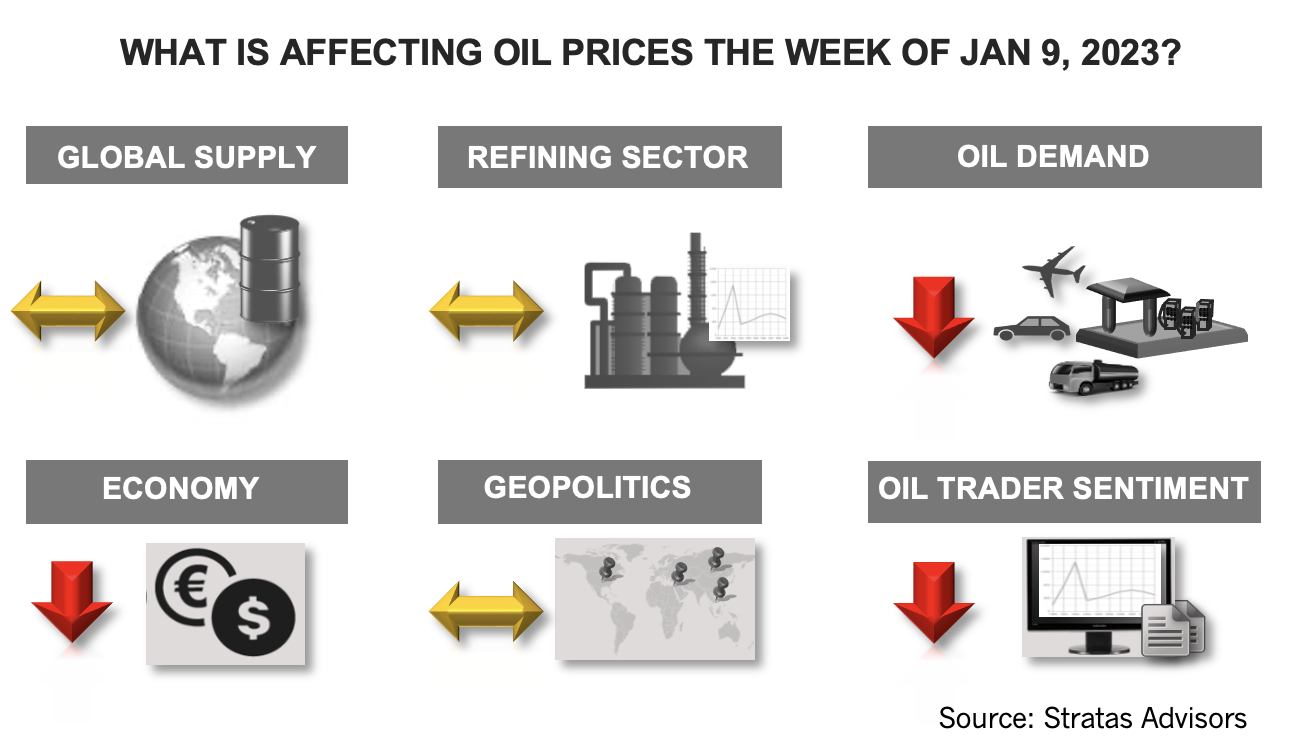
There are more signs that the US economy is slowing down and moving toward recession, according to the latest survey from the Institute for Supply Management. (Source: Tomasz Makowski / Shutterstock.com)
The price of Brent crude ended the week at $78.57 after closing the previous week at $85.91. The price of WTI ended the week at $73.77 after closing the previous week at $78.40.
Oil prices have moved into contango with future prices being higher than spot prices and to the greatest extent since November 2020, which is a sign that the market is adequately supplied. Further weakness is indicated by Saudi Arabia reducing its official selling price (OSP) for Arab Light destined for Asia in February. The decrease of $1.45/bbl reduces the premium above Dubai/Oman benchmark to $1.80/bbl, which is the lowest since November 2021. Saudi Arabia has also reduced its OSP for Europe (northwest Europe and Mediterranean).

Additionally, oil prices continue to be negatively affected by the economic news and data associated with the major economies.
- There are more signs that the U.S. economy is slowing down and moving toward recession. The latest survey from Institute for Supply Management shows that the forward-looking indicator for new orders decreased for the fourth consecutive month and has fallen to 45.2 (any reading below 50 indicates contraction), which is the lowest level since May of 2020. Even more worrisome is that the survey shows that the service sector decreased to 49.6 from 56.5 in November, which is the first reading below 50 since May of 2020. It appears that the Federal Reserve is intent on continuing with further increases in interest rates until the job market shows weakness. The jobs report for December indicates that the number of nonfarm jobs increased by 223,000 in December and that the unemployment rate fell to 3.5%. However, the labor force participation rate remains a full percentage point below pre-COVID level at 62.3%. Additionally, wages only increased by 0.3% in comparison to November and 4.6% in comparison to the previous year. Furthermore, the Household Data from the U.S. Bureau of Labor Statistics highlights that the labor market is not near as robust as indicated by the jobs report. The Household Survey shows that the number of fulltime workers in the U.S. has actually declined from August 2022 (132,336,000 to 132,299,000), while part-time positions have increased (26,250,000 to 26,794,000) along with the number of multiple jobholders (7,747,000 to 8,046,000). Furthermore, the survey shows that the number of workers in the age group of 25 to 54 fell from 102,028,000 to 101,848,000.
- China continues to move way from its zero-COVID policies with the process that started in mid-November 2022. However, the reopening and the return to normal economic and social activity has a ways to go, as indicated by subway ridership in major cities having only reached two-thirds of the level of the previous year. There are also concerns about an uptick in COVID-19 cases, which are likely to be boosted by the travel associated with the upcoming holidays starting on Jan. 21.
- While Europe is experiencing some reduction in inflationary pressures (in part because of decreasing cost of energy) prices still increased by 9.2% in December, which give the ECB further support for additional interest rate increases.
From a supply side perspective, more of the Russian crude exports are being shifted to Asia with China and India continuing to buy crude oil from Russia, despite the price cap of $60 on Russian oil exports that was imposed by the G7 countries, the European Union and Australia on Dec. 5, 2022. In November, Russia became the largest supplier to India, while major Chinese buyers of Russian crude oil are the independent (teapot) refineries.
For a complete forecast of refined products and prices, please refer to our Short-term Outlook.
About the Author: John E. Paise, president of Stratas Advisors, is responsible for managing the research and consulting business worldwide. Prior to joining Stratas Advisors, Paisie was a partner with PFC Energy, a strategic consultancy based in Washington, D.C., where he led a global practice focused on helping clients (including IOCs, NOC, independent oil companies and governments) to understand the future market environment and competitive landscape, set an appropriate strategic direction and implement strategic initiatives. He worked more than eight years with IBM Consulting (formerly PriceWaterhouseCoopers, PwC Consulting) as an associate partner in the strategic change practice focused on the energy sector while residing in Houston, Singapore, Beijing and London.
Recommended Reading
Is Double Eagle IV the Most Coveted PE-backed Permian E&P Left?
2024-04-22 - Double Eagle IV is quietly adding leases and drilling new oil wells in core parts of the Midland Basin. After a historic run of corporate consolidation, is it the most attractive private equity-backed E&P still standing in the Permian Basin?
EnQuest Selling Stake in North Sea Golden Eagle Oilfield, Sources Say
2024-04-16 - EnQuest has struggled in recent years with high debt levels and a drop in profits after Britain imposed a 35% windfall tax on North Sea producers.
Marketed: Paloma Natural Gas Eagle Ford Shale Opportunity in Frio County, Texas
2024-02-16 - Paloma Natural Gas has retained EnergyNet for the sale of a Eagle Ford/ Buda opportunity in Frio County, Texas.
Elk Range Royalties Makes Entry in Appalachia with Three-state Deal
2024-03-28 - NGP-backed Elk Range Royalties signed its first deal for mineral and royalty interests in Appalachia, including locations in Pennsylvania, Ohio and West Virginia.
SilverBow Gears Up for Proxy Fight with Kimmeridge
2024-04-09 - Both SilverBow Resources and Kimmeridge Energy Management have proposed a slate of candidates for the board of directors with a vote set for May 21.



